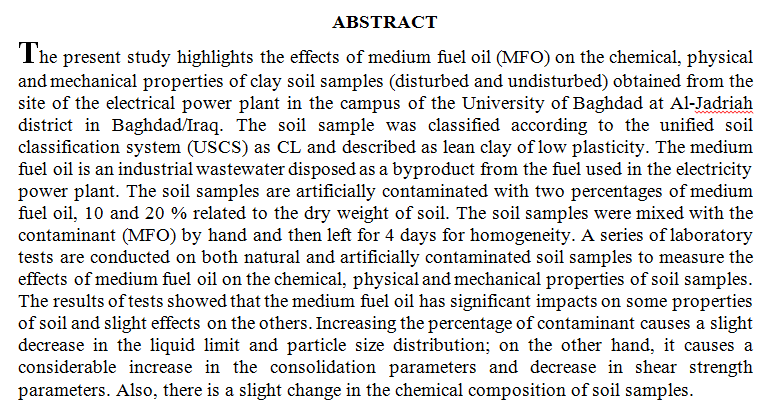
This research deals with study of the effect of additives on rheological properties (yield point, plastic viscosity ,and apparent viscosity) of emulsions. Twenty seven emulsion samples were prepared; all emulsions in this investigation are invert emulsions when water droplets are dispersed in diesel oil. The resulting emulsions are called water-in-oil (W/O) emulsions. The rheological properties of these emulsions were investigated using a couett coaxial cylinder rotational viscometer (Fann-VG model 35 A), by measuring shear stress versus shear rate. It was found that the effect of additives on rheological properties of emulsions as follow: the increase in the concentration of asphaltic material tends to increase the rheological propertie
... Show More (6)
(6)
Alginate from Large brown seaweeds act as natural polymer has been investigated as polymer and has been added to concrete in different percentages ( 0% , 0.5% , 1% and 1.5% ) by the cement weight and the study show the effect of using alginate biopolymer admixtures on some of the fresh properties of the concrete (slump & the density fresh) also in the hardened state ( Compressive strength , Splitting tensile strength and Flexural strength ) at 28 days. The mix proportion was (1:2.26:2.26) (cement: sand: gravel) respectively and at constant w/c equal to 0.47. The results indicate that the use of alginate as a percent of the cement weight possess a positive effect on fresh properties of co
... Show More (7)
(7)
 (8)
(8)
 (10)
(10)
The electrical properties of polycrystalline cadmium telluride thin films of different thickness (200,300,400)nm deposited by thermal evaporation onto glass substrates at room temperature and treated at different annealing temperature (373, 423, 473) K are reported. Conductivity measurements have been showed that the conductivity increases from 5.69X10-5 to 0.0011, 0.0001 (?.cm)-1 when the film thickness and annealing temperature increase respectively. This increasing in ?d.c due to increasing the carrier concentration which result from the excess free Te in these films.
 (12)
(12)
 (6)
(6)
 (1)
(1)
The reuse or recycling of waste materials in different aspects of life is served the objective of sustainability and be beneficial to society. In recent years, a wide variety of waste materials were used in pavement construction. One of these materials is glass that generally produces in large quantities and crushed glass can be considered feasible alternative source of aggregate for asphalt mixture production. This study focused on examining the asphalt mixture properties of wearing course using crushed glass as fine aggregates. Fine crushed glass with various percentages by total weight retained on sieve 2.36 mm, 0.3 mm and 0.075 mm was used in the study. The results indicate that mixes containing crushed glass had lower Marshall stabilit
... Show MoreThin films of ZnSxSe1-x with different sulfide content(x)
(0, 0.02, 0.04, 0.06, 0.8, and 0.1), thickness (t) (0.3, 0.5, and 0.7 μm) and annealing temperature (Ta) (R.T 373 and 423K) were fabricated by thermal evaporating under vacuum of 10-5 Toor on glass substrate. The results show that the increasing of sulfide content (x)and annealing temperature lead to decrease the d.c conductivity σDC of and concentration of charge carriers (nH) but increases the activation energy (Ea1,Ea2), while the increasing of t increases σDC and nH but decrease (Ea1,Ea2). The results were explained in different terms
In this study, geopolymer mortar was designed in various experimental combinations employing 1% micro steel fibers and was subjected to different temperatures, according to the prior works of other researchers. The geopolymer mortar was developed using a variety of sustainable material proportions (fly ash and slag) to examine the influence of fibers on its strength. The fly ash weight percentage was 50%, 60%, and 70% by slag weight to study its effect on the geopolymer mortar's properties. The optimal ratio produced the most significant results when mixed at a 50:50 ratio of fly ash and slag with 1% micro steel fibers at curing temperature 240oC for 4 hours through two days. The compressive strength of the geopolymer mortar increas
... Show More (11)
(11)
